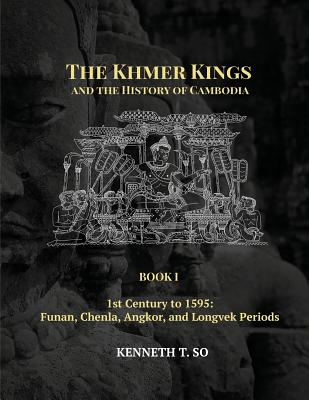The Khmer Kings and the History of Cambodia: BOOK I - 1st Century to 1595: Funan, Chenla, Angkor and Longvek Periods

The Khmer Kings and the History of Cambodia: BOOK I - 1st Century to 1595: Funan, Chenla, Angkor and Longvek Periods
The history of Cambodia is essentially the history of the Khmer kings. Power can be very seductive and addictive; and for this reason, kings or people with power would not voluntarily relinquish what they had and they would use any means necessary to maintain their control for absolute power. Sometimes it was easier for the king to rule his country than his family. This was certainly true for Cambodia when the kings begat many children from their multiple wives and concubines, creating many possible successors in competition for his throne. These shared bloodlines, across multiple generations, resulting in complicated and tumultuous family relationships wherein the family members would conspire against one another for power or the right to rule.
This book also discusses the origin of the Khmers and how Chenla, the state under the vassalage of Funan, came to conquer its master state, but ultimately the kingdom had to split into the Land and Water Chenla. The breakup of Chenla brought chaos and civil wars into the region. Srivijaya (Java) invaded Water Chenla and subjugated the country to a vassal state before Jayavarman II declared Kambuja's independence from Java. A new emerging period sprung up and Angkor, also known as the Kambuja Period, replaced Chenla as the dominant state in the region. The ascendancy of Angkor reached its zenith under the reigns of Suryavarman II, the builder of Angkor Wat, and Jayavarman VII, the builder of Bayon.
The emergence of Ayutthaya brought economic and military challenges to Angkor, which resulted in the fall of Angkor. The rivalry between Ayutthaya and Angkor pushed the Khmer kings to relocate their capitals farther east which started a new period, known as the Longvek period.
Throughout the above periods, the Chief Brahman priests who held hereditary functions since the time of Jayavarman II were always involved in the affairs of the state and were close advisors to the kings. Their roles in shaping up the policies and affairs of the country were second only to those of the kings.
371.59Lei
371.59Lei
Livrare in 2-4 saptamani
Descrierea produsului
The history of Cambodia is essentially the history of the Khmer kings. Power can be very seductive and addictive; and for this reason, kings or people with power would not voluntarily relinquish what they had and they would use any means necessary to maintain their control for absolute power. Sometimes it was easier for the king to rule his country than his family. This was certainly true for Cambodia when the kings begat many children from their multiple wives and concubines, creating many possible successors in competition for his throne. These shared bloodlines, across multiple generations, resulting in complicated and tumultuous family relationships wherein the family members would conspire against one another for power or the right to rule.
This book also discusses the origin of the Khmers and how Chenla, the state under the vassalage of Funan, came to conquer its master state, but ultimately the kingdom had to split into the Land and Water Chenla. The breakup of Chenla brought chaos and civil wars into the region. Srivijaya (Java) invaded Water Chenla and subjugated the country to a vassal state before Jayavarman II declared Kambuja's independence from Java. A new emerging period sprung up and Angkor, also known as the Kambuja Period, replaced Chenla as the dominant state in the region. The ascendancy of Angkor reached its zenith under the reigns of Suryavarman II, the builder of Angkor Wat, and Jayavarman VII, the builder of Bayon.
The emergence of Ayutthaya brought economic and military challenges to Angkor, which resulted in the fall of Angkor. The rivalry between Ayutthaya and Angkor pushed the Khmer kings to relocate their capitals farther east which started a new period, known as the Longvek period.
Throughout the above periods, the Chief Brahman priests who held hereditary functions since the time of Jayavarman II were always involved in the affairs of the state and were close advisors to the kings. Their roles in shaping up the policies and affairs of the country were second only to those of the kings.
Detaliile produsului










